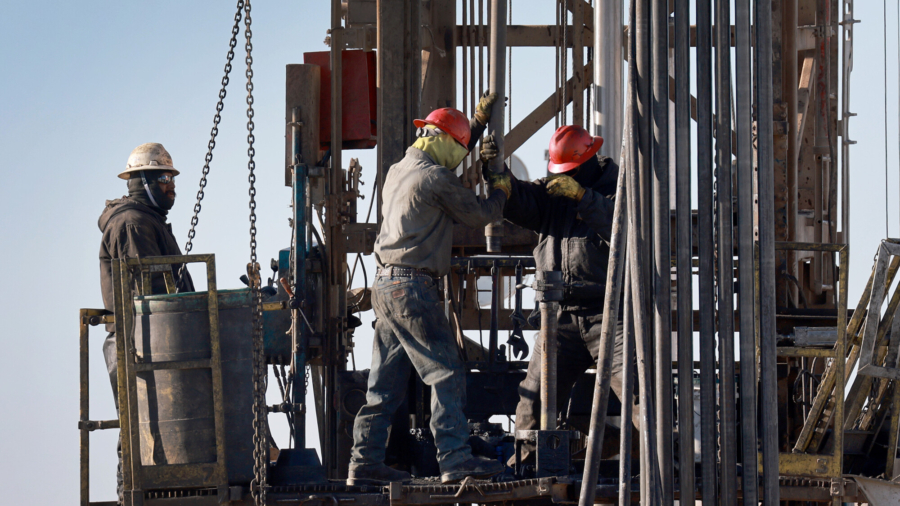Texas oil pipeline operators are preparing to increase the volume of crude oil flowing through pipelines from domestic shale fields to its hubs on the Gulf Coast to pre-pandemic levels by October 2022, according to analysts.
U.S. crude oil had been trading at about $100 a barrel, a boon for some Texas oil pipeline operators struggling after a period of low demand.
Oil prices jumped on May 11 after closing below $100 a barrel the previous day, as COVID-19 cases appeared to be easing in China and a revised April inflation report came in higher than expected, leading to a reversal of a prior-session selloff.
The April consumer price index showed inflation dropping slightly to 8.3 percent, higher than the original 8.1 percent estimate but lower than the four-decade high of 8.6 percent in March.
West Texas Intermediate crude climbed $4.92, or 4.9 percent, to $104.68 a barrel on the New York Mercantile Exchange.
The Energy Information Administration said that U.S. crude inventories jumped by 8.5 million barrels the week ending May 6. Gasoline inventories dropped 3.6 million barrels, an increase from the forecast drop of 1.9 million barrels, but distillate stocks were down only 900,000 barrels, less than the predicted loss of 1.6 million barrels.
Oil production in the Permian Basin of West Texas and New Mexico is rising toward a predicted rate of 5.7 million barrels per day (bpd) in 2023, which is still below the pipeline capacity of about 6.6 million bpd, energy analysts say.
The COVID-19 pandemic shuttered a pipeline construction boom in the United States that had increased the flow of oil by 2.5 million bpd from West Texas to export hubs on the Gulf Coast.
After oil prices tumbled at the start of the pandemic, overcapacity led pipeline operators to slash rates and provide easy terms for customers. But the gap between the coastal price and the price at the pipeline’s origination point in Midland, Texas, is beginning to widen again after contracting during the pandemic, which is a sign of rising shipping prices, Reuters reported.
Pipeline use from the Permian fields to the Texas Gulf Coast is set to rise from 70 percent in April to about 77 percent of pre-pandemic capacity by October 2022 and 80 percent by the end of the year.
The major pipeline companies make the bulk of their money from long-term contracts with producers and refiners who guarantee payment even if users do not ship the oil.
Companies such as Magellan Midstream Partners, Enterprise Product Partners, and Energy Transfer offered their customers easy terms under existing contracts and agreed to reduce rates when the contracts were renegotiated to preserve their long-standing relationships, rather than force them to keep paying during the downturn at the height of the pandemic.
Pipeline operators said they were still entering shorter-term contracts, since spreads were still low, but had plans to switch to longer-term contracts once the arbitrage picks up.
Oil rig counts in the Permian basin, which are an indicator of future production, have climbed 14 percent so far in 2022, and more energy firms have announced that they plan to raise capital spending for a second straight year to build additional rigs and increase production.
However, several service companies that normally supply equipment to the rigs have mothballed much of their equipment during the pandemic and it has been made worse by global supply chain bottlenecks.
The supply bottlenecks have forced some shale producers to pause operations, according to The Wall Street Journal, for days, weeks, or even months, while they wait for more equipment and supplies.
The CEO of a large fracking company, Robert Drummond of Oilfield Solutions Inc., told The Wall Street Journal that until suppliers build more fracking equipment, U.S. oil production growth will be limited to less than 1 million barrels a day annually.
Equipment shortfalls could persist into 2023 if oil-field service companies are unable to raise capital investments and are forced to restrict spending to maintaining, rather than building new rigs, according to industry executives.
The national skilled worker shortage since 2020 is also hitting the pipeline industry, as rig and pipeline specialists frequently leave for better pay elsewhere. Some of the previous big investors from only a few years ago are now reluctant to provide operators with capital to invest in new fracking fleets and drilling rigs.
These issues combined may slow down any future expansion in operations.
Reuters contributed to this report.
From The Epoch Times

